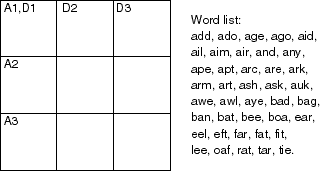
Place a letter in each square. You must find six three-letter words: three words read across (A1, A2, and A3) and three words read down (D1, D2, and D3). Each word must be chosen from the list of 40 possible words shown. You can solve it however you like, but please explain how you solved it. (This makes a good parlour game for the holiday Monday).
Please, please, please, don't tell anyone else the solution.
Solution: There are many ways to solve it.
X can win by moving into the left middle position.
X O O X X O
Fred, Jane, Harold, and Jennifer have all written programs to determine if, given a state of the game, X can win in the next move. Each of them has decided on different representation of the state of the game. The aim of this question is to compare their representations.
Fred decided to represent a state of the game as a list of three rows, where each row was a list containing three elements, either x, o, or b (for blank). Fred represents the above state as the list
[[x,o,o],[b,c,b],[x,b,o]].
Jane decided that each position on the square could be described by two numbers, the position across and the position up. The top left X is in position pos(1,3), the bottom left X is in position pos(1,1), and so forth. She then decided to represent the state of the game as a pair ttt(XPs,OPs) where XPs is the list of X's positions and OPs is the list of O's positions. Thus Jane represented the above state as
ttt([pos(1,3), pos(2,2), pos(1,1)], [pos(2,3), pos(3,3), pos(3,1)]).
Harold and Jennifer both realized that the positions on the tic-tac-toe board could be represented in terms of a so-called magic square:
Based on this representation, the game is transformed into one where the two players alternately select a digit. No digit can be selected twice, and the player who first selects three digits summing to 15 wins.
6 7 2 1 5 9 8 3 4
Harold decides to represent a state of game as a list of nine elements, each of which is x, o, or b, depending on whether the corresponding position in the magic square is controlled by X, controlled by O, or is blank. Thus Harold represents the game state above as the list:
[b, o, b, o, x, x, o, x, b].
Jennifer decides to represent the game as a pair consisting of the list of digits selected by X and the list of digits selected by O. She represented the state of the game above as
magic([6, 5, 8], [7,2, 4]).
You can use the relations "V is E" which is true if arithmetic expressions E has value V, "X != Y" which is true if ground terms X and Y are not identical, member(E,L) which is true of E is a member of list L, and any other predicates you want to define.